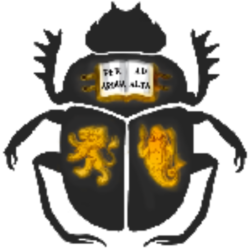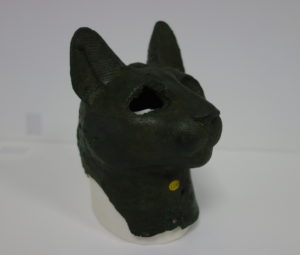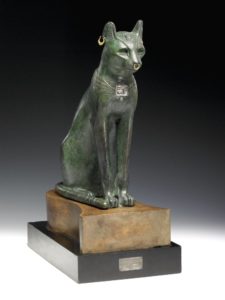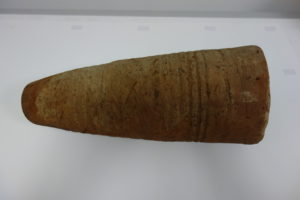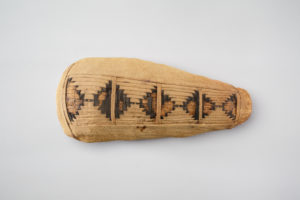Gifts for the Gods
Animal Votives and Mummies in Ancient Egypt
Brooke Norton
Mummification in Ancient Egypt was reserved not only for humans but also for certain animals. Animal mummies and cults such as the Apis Bull cult of Memphis have a long history stretching back to the Predynastic and Early Dynastic Periods (c. 4000-2686 BC). Animals in Ancient Egypt were mummified for reasons sacred and profane; they have been found interred in tombs both as victual mummies meant to serve as an eternal food source for the tomb owner in the afterlife and as beloved pets. Certain animals were mummified and buried because they were worshipped as an incarnation of a god during their lifetime or they were offered as dedications to gods and goddesses to whom the animal was sacred.[1] The quality of animal votives, coffins, and effigies varied – the more simple wrappings and casings would have been a cheaper alternative to cartonnage masks or cast bronze statuettes. Votive mummies are conventionally thought to have been produced for the use of pilgrims who would place them at the shrines of sacred cult sites; however, it has been argued that animals that lived and died within temple enclosures may also have been mummified and buried in sacred animal necropolises.[2]
Sacred animals would have been worshipped as the living manifestations of certain gods and goddesses at cult sites located throughout Egypt. Animal necropolises dedicated to these animals have been found throughout the country – from the Sacred Animal Necropolis at North Saqqara in Lower Egypt where thousands of sacred bulls, ibises, baboons, and cats were buried, to Elephantine in Upper Egypt where rams, ibises, and raptors were worshipped. Although animal cults existed from the Predynastic Period (c. 4000-3000 BC) onwards, animal cults became increasingly popular and abundant during the Ptolemaic and Roman Periods (332 BC-395 AD). This has been attributed to an archaising tendency stemming from the desire to return to traditional Egyptian religious customs after centuries of foreign rule by Libyans, Persians, and Assyrians.
|
|
Originally recorded as a mask for a feline mummy, this object in the Eton Myers Collection of Egyptian Art (ECM 6522) is most likely an example of a cast bronze statue of a cat, a popular Ptolemaic Period style effigy. Standing at a maximum height of 14.90 cm this fragmentary statue – it breaks off below the neck – is 9.25 cm at its widest and 11.59 cm in depth. This type of statue would most likely have been created by pouring molten bronze into a mould –made from materials such as stone, pottery, and sand. Another possibility is that the craftsman would have employed the lost-wax casting process whereby wax would
|
|
have been moulded around a core in order to save metal.[3] The bronze head has pierced ears, however they no longer contain the earrings common to other examples of such effigies. In addition, the scarab incised on the top of the head relates to the sun god, and can be seen on other Late Period (664-332 BC) and Ptolemaic cat statues as well. The Eton Myers statue perhaps can be reconstructed as a seated cat that may have been adorned with a collar depicting solar imagery such as a winged scarab or wadjet eye – as can been seen in the famous Gayer-Anderson cat in the British Museum (EA64391) and object 56.16.1 at the Metropolitan Museum.[4]
Cat votive statues were most likely associated with the goddess Bastet, whose main cult centres were at Bubastis and Saqqara. This type of bronze effigy would have been dedicated to the goddess and buried either at a main cult site or in one of many animal necropolises associated with this goddess. ECM 6522 in the Eton Myers Collection possibly contained a feline mummy at one time.
Another animal mummy in the Eton Myers Collection (ECM 6230) is a fragilely wrapped ibis mummy accompanied by a conical ceramic vessel in which it would have been interred. Ibises were sacred birds of the god Thoth – god of wisdom, writing, and medicine – and would have been offered at cult sites, including one of the most important at Tuna el-Gebel, located near the ancient town Hermopolis in Middle Egypt. The Eton Myers ibis is likely a votive mummy that would have been placed within its ceramic vessel and buried as a dedication to Thoth, although it is impossible to say for sure since this object was purchased on the antiquities market and thus the context in which it was found cannot be accurately reconstructed. During the Late and Ptolemaic periods, there was an extensive hierarchy of priests and craftsmen devoted to raising and mummifying the sacred birds.[5] It was quite common for ibises to be bred, hatched, and raised within nearby colonies associated with temples; Tuna el-Gebel, for example, would have contained an ibis sanctuary.[6]
|
|
Frequently ibises were wrapped in linen and placed either within conical ceramic pots – individually or sometimes with as many as three to seven ibises in one jar – or in coffins and effigies during the mummification process.[7] During the Graeco-Roman Period (332 BC-395 AD) it was common for ibis mummies to be defleshed and wrapped in linen using complex patterns. At Tuna el-Gebel there are numerous examples of ibises wrapped and placed in sealed pottery vessels and then placed in galleries; alternatively they could have been dipped in resin.[8] ECM 6230 in the Eton Myers Collection was likely simply wrapped in linen, as opposed to the very complex Late Period wrappings, and was placed in a conical, vessel measuring at 41.50 cm in length with a maximum rim diameter of 17.00 cm (max rim thickness 1.38 cm). With little of the ibis mummy’s remains preserved, it is impossible to determine which type of mummification process was implemented.
These two animal votives from the Eton Myers Collection both exemplify a long tradition of animal mummification that has its roots in one of the earliest periods of Egyptian history. The ancient Egyptians would have reverently mummified and prepared these votives to be offered up to the gods Bastet and Thoth. Thus not only was the preservation of the human body important to the Egyptians but also ensuring the eternal life of these sacred animals, gifts to the gods.
[expand title=”Endnotes”]
[1] Ikram 2005: 3-5
[2] Ikram 2005 :10; Kessler and Nur el-Din 2005: 155
[3] Nicholson and Shaw 2009: 157-158; Shoosmith 2016
[4] Metropolitan Museum 56.16.1
[5] Nicholson 2005: 49-50
[6] Driesch et al. 2005: 204; Kessler and Nur el-Din 2005: 127
[7] Driesch et al. 2005: 208
[8] Ikram 2005: 24; Kessler and Nur el-Din 2005: 156
[/expand]
[expand title=”Bibliography and Further Reading”]
von den Driesch, A., Berteaux, V., Kessler, D., Peters, J., and Steinmann, F. 2005. “Mummified, Deified and Buried at Hermopolis Magna—The Sacred Birds from Tuna el-Gebel, Middle Egypt”. Ägypten und Levante 15, 203-244.
Ikram, S. 2005. “Divine Creatures: Animal Mummies”, in S. Ikram (ed.), Divine Creatures: Animal Mummies in Ancient Egypt. Cairo, 1-15.
Kessler, D. and Nur el-Din, A. 2005. “Tuna al-Gebel: Millions of Ibises and Other Animals”, in S. Ikram (ed.), Divine Creatures: Animal Mummies in Ancient Egypt. Cairo, 120-163.
Nicholson, P. T. 2005. “The Sacred Animal Necropolis at North Saqqara: The Cults and Their Catacombs” in S. Ikram (ed.), Divine Creatures: Animal Mummies in Ancient Egypt. Cairo, 44-71.
Ogden, J. 2000. “Metals”, in Nicholson, P. and I. Shaw. (ed.), Ancient Egyptian Materials and Technology. Cambridge, 148-176.
Shoosmith, Z. 2016, “Life Through Wax: Beeswax in Ancient Egypt”, in S. Boonstra (ed.), Objects Come to Life.
https://more.bham.ac.uk/birminghamegyptology/virtual-museum/objects-come-to-life/life-through-wax/
Strudwick, N. 2006. Masterpieces of Ancient Egypt. London.
Wilkinson, R.H. 1992. Reading Egyptian Art. London.
[/expand]
